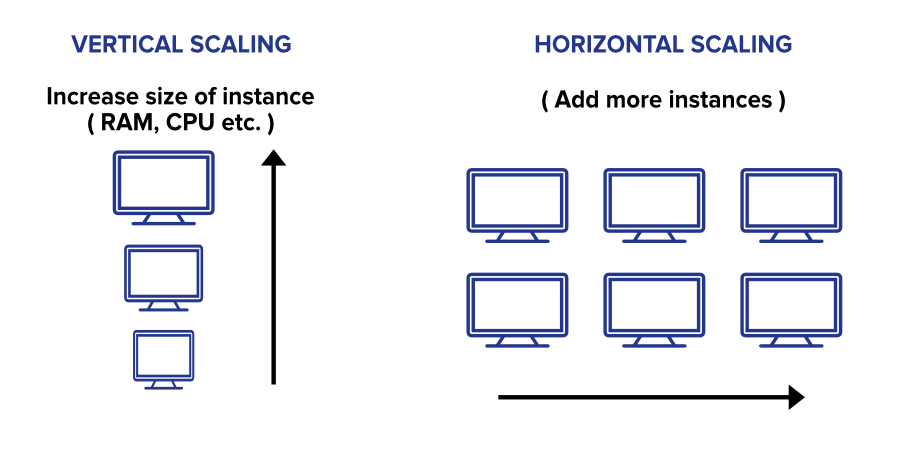- Published on
System Design: Vertical Scaling vs. Horizontal Scaling
- Authors
- Name
- Full Stack Engineer
- @fse_pro
  |   |
|---|
When designing a system that needs to handle increasing amounts of traffic and workload, scaling becomes a crucial consideration. Scaling refers to the ability of a system to handle more load and traffic as demands increase. There are two main approaches to scaling a system: vertical scaling and horizontal scaling. In this article, we will explore the differences between these two approaches and their advantages and disadvantages.
Table of Contents
- Introduction
- Vertical Scaling
- Horizontal Scaling
- Vertical Scaling vs. Horizontal Scaling: When to Choose
- Conclusion
- Resources
Introduction
In the context of system design, scaling refers to the process of increasing a system's capacity to handle more requests, users, or data. As a system's load grows, it's essential to scale to ensure optimal performance and reliability. Two common approaches to scaling are vertical scaling and horizontal scaling. Each approach has its trade-offs, and the decision to choose one over the other depends on various factors.

Vertical Scaling
Vertical scaling, also known as scaling up, involves adding more resources to a single server or node to handle increased load. These resources typically include CPU, RAM, and storage capacity. Vertical scaling is often accomplished by upgrading the existing hardware, such as replacing a CPU with a more powerful one or adding more RAM to the server.
Pros of Vertical Scaling
Simplicity: Vertical scaling is relatively straightforward to implement since it involves upgrading existing hardware.
Performance Improvements: In some cases, vertical scaling can lead to significant performance improvements, especially if the bottleneck is a resource constraint on a single server.
Single System Management: With vertical scaling, you are dealing with a single server, which can be more manageable and easier to monitor.
Cons of Vertical Scaling
Cost: Upgrading hardware can be expensive, especially for high-end components.
Limited Scalability: There is a limit to how much a single server can be scaled vertically. Eventually, you may reach the maximum capacity of the hardware.
Single Point of Failure: Since all resources are concentrated on a single server, it becomes a single point of failure. If the server goes down, the entire system may become unavailable.
Horizontal Scaling
Horizontal scaling, also known as scaling out, involves adding more servers or nodes to distribute the workload across multiple machines. This approach aims to increase the system's capacity by adding more hardware units in a parallel manner.
Pros of Horizontal Scaling
Cost-Effective: Horizontal scaling can be more cost-effective than vertical scaling since it involves using commodity hardware that is generally less expensive.
Infinite Scalability: Horizontal scaling allows for virtually limitless scalability. You can keep adding more servers as needed to handle increased load.
High Availability: Since the workload is distributed across multiple servers, the failure of one server does not bring down the entire system. This leads to improved fault tolerance and availability.
Cons of Horizontal Scaling
Complexity: Horizontal scaling can be more complex to implement compared to vertical scaling, especially when dealing with distributed systems.
Network Overhead: As the system grows and more servers are added, there can be increased network communication and overhead.
Data Consistency: Maintaining data consistency can be challenging in a horizontally scaled system, especially when dealing with distributed databases.
Vertical Scaling vs. Horizontal Scaling: When to Choose
The choice between vertical scaling and horizontal scaling depends on several factors, including:
Workload Growth: If your system's workload is expected to grow gradually and can be easily handled by a single server, vertical scaling might be sufficient. However, if you expect rapid and significant growth, horizontal scaling might be a better choice.
Resource Constraints: If your system is limited by the capacity of a single server, such as CPU or RAM, vertical scaling can provide immediate performance improvements. On the other hand, if you need to scale beyond the capabilities of a single server, horizontal scaling is the way to go.
Cost Considerations: Vertical scaling can be more expensive, especially for high-end hardware upgrades. Horizontal scaling, using commodity hardware, can offer a more cost-effective solution.
High Availability Requirements: If your system needs to be highly available and fault-tolerant, horizontal scaling is a better option as it reduces the risk of a single point of failure.
Conclusion
In summary, both vertical scaling and horizontal scaling are essential approaches to handle the increasing demands of a system. Vertical scaling involves adding more resources to a single server, while horizontal scaling involves distributing the workload across multiple servers. The choice between the two depends on factors such as workload growth, resource constraints, cost considerations, and high availability requirements.
For many modern systems, a combination of both approaches, known as elastic scaling, is used. Elastic scaling allows a system to automatically adjust its resources based on demand, combining the benefits of both vertical and horizontal scaling.
Remember that the decision to scale should be based on careful analysis and testing of your system's requirements and limitations. Additionally, consider the long-term scalability and potential bottlenecks when designing your system.